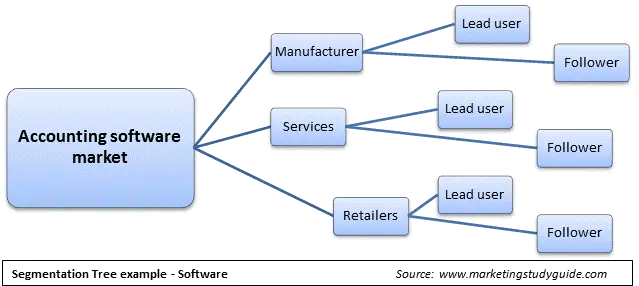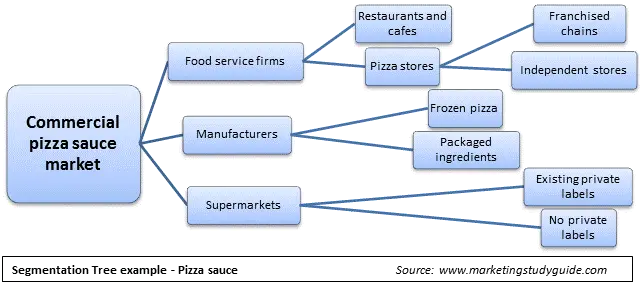B2B Segmentation Examples
Segmenting business markets is essentially the same as segmenting consumer markets.
You should also review examples for segmenting consumer markets.
The key difference is that you need to consider more business-oriented segmentation bases.
To help explain this concept further, let’s look at a couple of examples of business market segmentation.
The first is for an IT firm that produces accounting software for businesses. The following diagram outlines a possible segmentation tree for them.
In this business market segmentation example, the firm has used two segmentation variables to construct six market segments. The first variable used is a basic business description, splitting the market into the broad categories of manufacturing, services, and retailing.
Then the firm has applied a cultural variable and considered whether the potential customers tend to adopt new products (in this case, major accounting software) early or late.
Let’s look at another business segmentation example, this time we will use a manufacturer of tomato paste that is suitable for use as a pizza topping. Here is a possible segmentation approach for this firm:
In this example, a variety of segmentation variables have been used in order to construct an interesting definition of market segments. The first variable considered is a business description, which broadly splits the potential market into food service, manufacturing, and supermarkets. Then, for each broad group, a different variable has been injected. For instance, food service was then further split by business description (restaurant/café or pizza outlet) and then by operating practice (whether or not they are a franchised operation).
Manufacturers are further defined by whether they use pizza sauce as a key ingredient (say for frozen pizza) or may use this style of sauce in other products (frozen or microwavable pasta for example). And finally supermarkets were further defined by whether or not they already sell a private label pizza sauce through their stores.
Marketing Automation Software Provider Example
A marketing automation software firm segments its business market to better target potential customers in the B2B space. The segmentation starts with the industry type:
- Technology Firms: These businesses need advanced tools to track digital campaigns, manage leads, and automate email marketing. Within this group, the firm segments further by company size:
- Startups: Require cost-effective solutions with limited features tailored to small teams.
- Mid-Sized Firms: Seek scalable platforms that integrate with existing CRM systems.
- Large Enterprises: Demand highly customizable solutions with advanced analytics, compliance features, and dedicated account management.
- Retail Businesses: Focus on customer segmentation and loyalty programs. This group is segmented by operating practices:
- E-Commerce Companies: Require automated cart abandonment emails and personalized recommendations.
- Brick-and-Mortar Stores: Seek omnichannel solutions to combine in-store and online customer data.
By layering segmentation variables such as industry, company size, and operating practices, the software firm identifies distinct segments, allowing them to craft targeted marketing and sales strategies.
Commercial Vehicle Manufacturer Example
A commercial vehicle manufacturer segments its business market to optimize its product offerings. The segmentation begins with customer type:
- Logistics Companies: Require vehicles with high fuel efficiency and large cargo capacity. This segment is further divided by fleet size:
- Small Fleets (1–10 vehicles): Focused on affordability and reliability.
- Large Fleets (10+ vehicles): Prioritize total cost of ownership, including fuel economy, maintenance plans, and resale value.
- Construction Companies: Need rugged, heavy-duty vehicles to transport materials to job sites. This group is further segmented by geographic location:
- Urban Construction Firms: Require compact vehicles suitable for navigating city streets.
- Rural Construction Firms: Prefer large, off-road-capable trucks for remote job sites.
This approach ensures the manufacturer tailors its offerings, such as financing options for small logistics firms or custom configurations for rural construction companies.
Office Furniture Supplier Example
An office furniture supplier segments its market to focus on distinct business needs. The segmentation starts with business description:
- Startups: Typically need affordable, modular furniture that accommodates small spaces and tight budgets. This group is segmented further by growth goals:
- Rapidly Scaling Startups: Require flexible furniture systems that can expand as the team grows.
- Bootstrapped Startups: Focus on durable, cost-effective solutions for basic office needs.
- Established Corporations: Tend to invest in premium furniture that enhances workplace aesthetics and ergonomics. This segment is further divided by operating practices:
- Centralized Procurement: Decisions are made at corporate headquarters, requiring a standardized catalog for multiple offices.
- Decentralized Procurement: Local offices have autonomy, demanding personalized consultations and localized inventory.
- Co-Working Spaces: Require innovative furniture solutions for shared environments, such as desks with integrated power outlets and adaptable layouts for different user groups.
This segmentation allows the supplier to tailor marketing messages, offer specific product bundles, and develop sales strategies suited to each segment’s unique needs.
Important topics


